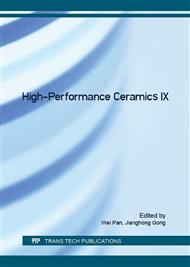p.239
p.243
p.248
p.253
p.257
p.262
p.267
p.271
p.275
Phase Evolution and Properties of Li2O-Al2O3-SiO2-Based Glass-Ceramic for LTCC Applications
Abstract:
In this paper, the influences of sintering conditions on the phase transformation, microstructure, bulk density, bending strength, coefficient of thermal expansion, and dielectric properties of Li2O-Al2O3-SiO2 glass-ceramic were investigated. Conventional melt-quenching method was used to synthesize this glass-ceramic. Scanning electron microscopy, X-ray diffractometer and differential thermal analysis were employed to study this material. The XRD data show that Li2OAl2O37.5SiO2 is the main crystalline phase of this glass-ceramic. ZrO2 and CaMgSi2O6 are the two other phases in this glass-ceramic. The increasing sintering temperature and soaking time affect the phase composition obviously, which lead to the obvious variations of microstructure, mechanical, dielectric and thermal properties of this glass-ceramic. Sintering temperature and time play a key role in the sintering of Li2O-Al2O3-SiO2 glass-ceramic. The sample sintered at 800 °C for 30 min showed good microstructure, low sintering temperature of 800 °C, high density of ~2.6 g/cm3, excellent dielectric properties (εr: ~6.9, tan δ: ~2*10-3), good bending strength of 143 MPa and adjustable CTE from 1.1 to 2.7 *10-6 K-1 close that of silicon. These results mean that the obtained LAS glass-ceramic can be used in the application of LTCC substrate, especially, the manufacture of the substrate of silicon.
Info:
Periodical:
Pages:
257-261
Citation:
Online since:
July 2016
Authors:
Keywords:
Price:
Сopyright:
© 2016 Trans Tech Publications Ltd. All Rights Reserved
Share:
Citation:


